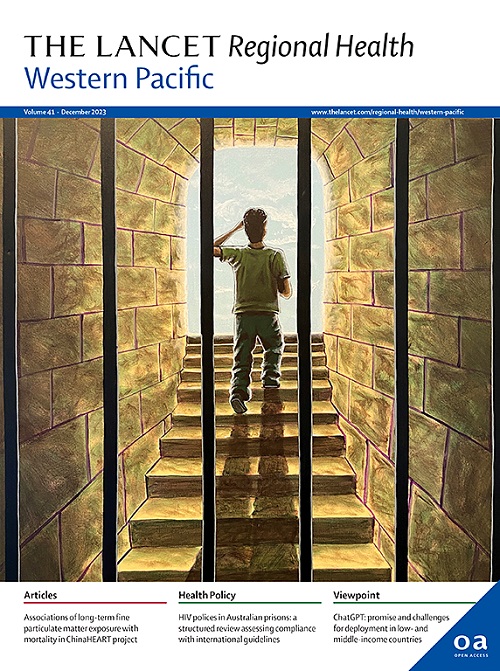Thymic characteristics in patients with autoimmune diseases: a multicentre radiological observational study
IF 8.1
1区 医学
Q1 HEALTH CARE SCIENCES & SERVICES
引用次数: 0
Abstract
Background
Autoimmune diseases comprise a spectrum of illnesses stemming from a common etiology: the loss of self-tolerance. The organ crucial for the establishment and maintenance of central and peripheral tolerance, namely the thymus, has rarely been explored across these diseases.
Methods
In a multicentre radiological case–control study, we characterized the thymus in 16 prevalent autoimmune diseases using chest computed tomography (CT) images from patients and age- and sex-1:1 matched healthy controls. Participants underwent a routine CT examination, and baseline information on demographic, clinical, and potential risk factors was gathered at the time of enrollment. A semi-automatic algorithm was developed and employed for the analysis of thymic radiological characteristics, encompassing structural features and density. Thymic fatty replacement was evaluated using a four-point visual scoring scale (0–3). This study is registered with the Chinese Clinical Trial Registry (ChiCTR2300078417).
Findings
After matching, 2441 participants in each group were included in case–control study. As individuals age, the thymus undergoes involution, leading to marked changes in thymic features over time, yet the degree of thymic feature alterations varies among groups. Compared to healthy controls, multiple characteristics of the thymus were distinct in the autoimmune disease patients, featuring higher trapezoidal proportions (68.21% vs 46.29%; p < 0.0001), larger bilobed size, and reduced density (−9.50; 95% CI, −10.95 to −8.04; p < 0.0001). In addition, the autoimmune disease patients displayed a greater proportion of fatty replacement (score 0, score 1, and score 2, 94.23% vs 87.83%, p < 0.0001). This consistent trend of thymic characteristic alternations, was observed across the 16 diseases (albeit varying in degree) and in newly diagnosed as early-stage patients. Notably, the subgroup for female patients of childbearing age (≤49 years) exhibited an especially prominent difference in thymic density (−16.23; 95% CI, −19.19 to −13.26; p < 0.0001 in all comparisons) and in the proportion of fatty replacement (85.37% vs 71.68%; p < 0.0001).
Interpretation
Radiological assessments reveal a consistent pattern of exacerbated age-dependent thymic involution across 16 autoimmune diseases, suggesting a common underlying mechanism in the development of these diseases. This mechanism may involve the compromise of self-tolerance due to thymic involution.
Funding
The National Key R&D Program of China, the National Science Foundation of China, and the Tianjin Key Medical Discipline (Specialty) Construction Project.
自身免疫性疾病患者胸腺特征:一项多中心放射观察研究
自身免疫性疾病包括一系列疾病,起因于一个共同的病因:丧失自我耐受性。对于中枢和外周耐受的建立和维持至关重要的器官,即胸腺,很少在这些疾病中被探索。方法在一项多中心放射学病例对照研究中,我们使用来自患者的胸部计算机断层扫描(CT)图像和年龄和性别1:1匹配的健康对照,对16种常见自身免疫性疾病的胸腺进行了特征描述。参与者接受了常规CT检查,并在入组时收集了人口统计学、临床和潜在危险因素的基线信息。开发了一种半自动算法,用于胸腺放射学特征的分析,包括结构特征和密度。胸腺脂肪替代采用4点视觉评分量表(0-3)进行评估。本研究已在中国临床试验注册中心注册(ChiCTR2300078417)。配对后,两组共纳入病例对照研究2441例。随着个体年龄的增长,胸腺经历了退化,导致胸腺特征随着时间的推移发生了显著的变化,但胸腺特征改变的程度在不同群体之间有所不同。与健康对照组相比,自身免疫性疾病患者胸腺的多种特征明显,胸腺的梯形比例更高(68.21% vs 46.29%;p & lt;0.0001),双叶尺寸较大,密度降低(−9.50;95% CI,−10.95 ~−8.04;p & lt;0.0001)。此外,自身免疫性疾病患者的脂肪替代比例更高(0分、1分和2分),94.23% vs 87.83%, p <;0.0001)。在16种疾病(尽管程度不同)和新诊断的早期患者中观察到胸腺特征改变的一致趋势。值得注意的是,育龄(≤49岁)女性患者亚组胸腺密度差异特别显著(−16.23;95% CI,−19.19 ~−13.26;p & lt;0.0001)和脂肪替代比例(85.37% vs 71.68%;p & lt;0.0001)。放射学评估揭示了16种自身免疫性疾病中年龄依赖性胸腺退化加剧的一致模式,提示这些疾病发展的共同潜在机制。这一机制可能涉及胸腺退化导致的自我耐受性的妥协。国家重点研发计划、国家自然科学基金、天津市医学重点学科(专业)建设项目。
本文章由计算机程序翻译,如有差异,请以英文原文为准。
求助全文
约1分钟内获得全文
求助全文
来源期刊

The Lancet Regional Health: Western Pacific
Medicine-Pediatrics, Perinatology and Child Health
CiteScore
8.80
自引率
2.80%
发文量
305
审稿时长
11 weeks
期刊介绍:
The Lancet Regional Health – Western Pacific, a gold open access journal, is an integral part of The Lancet's global initiative advocating for healthcare quality and access worldwide. It aims to advance clinical practice and health policy in the Western Pacific region, contributing to enhanced health outcomes. The journal publishes high-quality original research shedding light on clinical practice and health policy in the region. It also includes reviews, commentaries, and opinion pieces covering diverse regional health topics, such as infectious diseases, non-communicable diseases, child and adolescent health, maternal and reproductive health, aging health, mental health, the health workforce and systems, and health policy.
 求助内容:
求助内容: 应助结果提醒方式:
应助结果提醒方式:


